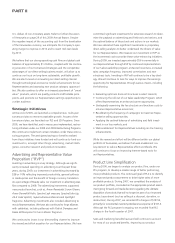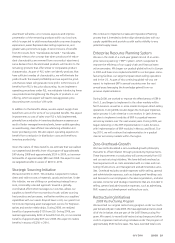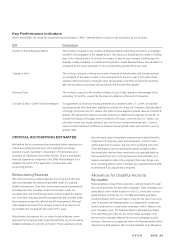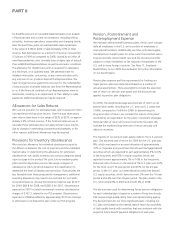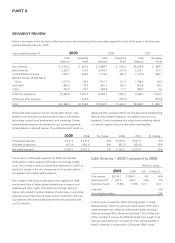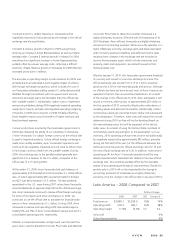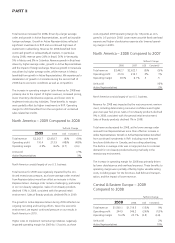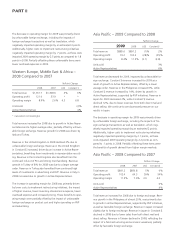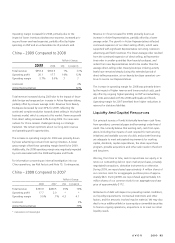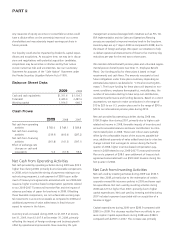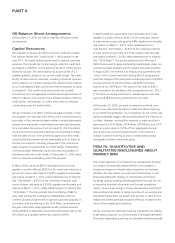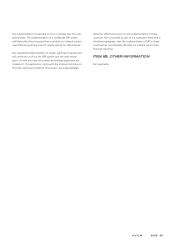Avon 2009 Annual Report Download - page 47
Download and view the complete annual report
Please find page 47 of the 2009 Avon annual report below. You can navigate through the pages in the report by either clicking on the pages listed below, or by using the keyword search tool below to find specific information within the annual report.
Constant $and U.S. dollars. Revenue in Venezuela will be
negatively impactedinfuture periods by the change in the official
exchange ratediscussed below.
Constant $revenue growth in Brazil for 2009 was primarily
driven by an increase in Active Representatives, as well as ahigher
average order. Constant $revenue growth in Mexico for 2009
was driven by asignificant increase in Active Representatives,
partially offset by alower average order, reflecting adifficult
economic climate. Revenue growth in Venezuela for2009 reflected
increased prices due to inflation.
The decrease in operating margin in Latin America for 2009 was
primarily due to an estimated 2point negative impact of unfavor-
able foreign exchange transactions, which includes the cost of
our Venezuelan subsidiary settling certain U.S. dollar-denominated
liabilities through transactions with non-government sources
where the exchange rate is less favorable than the official rate
(the “parallel market”). Additionally, higher costs to implement
restructuring initiatives during 2009 negatively impacted operating
margin by 0.7points, as thesecosts impacted operating margin by
0.9 points in 2009 and 0.2 points in 2008. Partially offsetting
these negative impacts was the benefit of higher revenues and
fixed overhead expense.
Currency restrictions enacted by the Venezuelan government in
2003 have impacted the ability of our subsidiary in Venezuela
(“Avon Venezuela”) to obtain foreign currency at the official rate
to pay for imported products. Unless official foreign exchange is
made more readily available, Avon Venezuela’s operations will
continue to be negatively impacted as it will need to obtain more
of its foreign currency needs from the parallel market. During
2009, the exchange rate in the parallel market generally aver-
aged from 5to6bolivars to the U.S. dollar, compared to the
official rate of 2.15 during 2009.
At December 31, 2009, Avon Venezuela had cash balances of
approximately $104 translated at the December 31, 2009 official
rate, of which approximately $83 was denominated in bolivars
and $21 was denominated in U.S. dollars. The last dividends
repatriated to the U.S. were during 2007, when Avon Venezuela
remitted dividends of approximately $40 at the official exchange
rate. Avon Venezuela continues to receive official foreign exchange
for some of its imports and other remittances. In 2009, we
continued to use the official rate to translate the financial state-
ments of Avon Venezuela into U.S. dollars. During 2009, Avon
Venezuela’s revenue and operating profit represented approx-
imately 5% and 9% of Avon’s consolidated revenue and Avon’s
consolidated operating profit, respectively.
Inflation in Venezuela has been at high levels over the past few
years. Avon uses the blended Consumer Price Index and National
Consumer Price Index to determine whether Venezuela is a
highly inflationary economy. Effective with the beginning of its
2010 fiscal year, Avon will treat Venezuela as ahighly inflationary
economy for accounting purposes. When an entity operates in a
highly inflationary economy, exchange gains and losses associated
with monetary assets and liabilities and deferred income taxes
resulting from changes in the exchange rate are recorded in
income. Nonmonetary assets, which include inventories and
property, plant and equipment, are carried forward at their
historical dollar cost.
Effective January 11, 2010, the Venezuelan government devalued
its currency and moved to atwo-tier exchange structure. The
official exchange rate moved from 2.15 to 2.60 for essential
goods and to 4.30 fornon-essential goods and services. Although
no official rules have yet been issued, most of Avon’s imports are
expected to fall into the non-essential classification. As aresult
of the change in the official rate to 4.30, Avon anticipates it will
record aone-time, after-tax loss of approximately $50 million in
the first quarter of 2010, primarily reflecting the write-down of
monetary assets and deferred tax benefits. Additionally, certain
nonmonetary assets are carried at historic dollar cost subsequent
to the devaluation. Therefore, these costs will impact the income
statement during 2010 as they will not be devalued based on
the new exchange rates, but will be expensed at the historic
dollar value. As aresult of using the historic dollar cost basis of
nonmonetary assets acquired prior to the devaluation, such as
inventory, 2010 operating profit and net income will additionally
be negatively impacted by approximately $85 million, primarily
during the first half of the year, for the difference between the
historical cost at the previous official exchange rate of 2.15 and
the new official exchange rate of 4.30. In addition, revenue and
operating profit for Avon’s Venezuela operations will be neg-
atively impacted when translated into dollars at the new official
exchange rate. This would be partially offset by the favorable
impact of any operating performance improvements. Results for
periods prior to 2010 will not be impacted by the change in
accounting treatment of Venezuela as ahighly inflationary
economy or by the change in the official rate in January of 2010.
Latin America –2008 Compared to 2007
%/Point Change
2008 2007 US$ Constant $
Total revenue $3,884.1 $3,298.9 18% 14%
Operating profit 690.3 483.1 43% 38%
Operating margin 17.8% 14.6% 3.2 3.0
Units sold 4%
Active Representatives 6%
AVON2009 29



